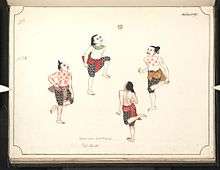Chinlone
Chinlone (Burmese: ခြင်းလုံး, pronounced [hkrang:lum:]), also known as caneball, is the traditional, national sport of Myanmar (Burma). It is non-competitive, with typically six people playing together as one team. The ball used is normally made from handwoven rattan, which sounds like a basket when hit. Similar to the game of hacky-sack, chinlone is played by individuals passing the ball among each other within a circle without using their hands. However, in chinlone, the players are walking while passing the ball, with one player in the center of the circle. The point of the game is to keep the ball from hitting the ground while passing it back and forth as creatively as possible. The sport of chinlone is played by men, women and children, often together, interchangeably. Although very fast, chinlone is meant to be entertaining and fluid, as if it were more of a performance or dance.[1]
History

Chinlone has played a prominent role in Myanmar for about 1,500 years. Its style is performance-based because it was first created as a means of entertaining Burmese royalty. Chinlone is heavily influenced by traditional Burmese martial arts and dance, another reason as to why so much importance is placed upon technique. As it is such an old game, many variations have been made to it, including hundreds of moves for maneuvering the ball. In addition to the original form of chinlone, there is a single performance style called tapandaing. While chinlone had been widely considered by Europeans to more of a game than a sport, international interest in chinlone grew rapidly. By 1911, chinlone teams were performing in parts of Europe and Asia. As spectators of chinlone, Europeans deemed it to be merely a game of indigenous people, too effeminate to be considered a sport.
After Myanmar's independence from British colonial rule in 1948, many British influences and cultural practices lingered, including those of British sports such as polo. Past British colonialism still weighed heavily upon Burmese life. From the 1960s onward, the government strongly promoted traditional and historical preservation in an effort to renew cultural pride.[2] Myanmar needed traditions that were unique to Burmese culture, free from any colonial influence. Chinlone fit this role perfectly, playing a key part in establishing Burmese nationalism. Myanmar began implementing physical education in schools, teaching children from a young age about traditional sports like chinlone as a way to educate and pride them on their culture.[3] This was a small yet effective way in reestablishing Burmese life after colonial rule. With this newfound nationalism, chinlone was finally considered a real sport.
The head of the Burma Athletic Association, U Ah Yein, was ordered by the Burmese government to write a rulebook for chinlone in 1953. These rules forced chinlone to become more competitive, and the first official chinlone competition was held in Yangon that same year. In addition to providing chinlone with an official set of rules, U Ah Yein's chinlone rulebook claimed chinlone to be unique to Myanmar only, as the birthplace of the game. While chinlone does distinctively go back far into Burmese tradition, there are many similar sports closely related to it across many other Southeast Asian countries, such as da cau (Vietnam), kator (Laos), sepak raga (Malaysia, Singapore, Brunei and Indonesia), sipa (Philippines) and takraw (Thailand).[4]

In the 2013 Southeast Asian Games
The 2013 Southeast Asian Games were hosted in the Burmese capital Nay Pyi Taw, the first Southeast Asian Games in Myanmar since 1969. Chinlone was included as a separate sport within the competition, and was also featured in the closing ceremony. The inclusion of chinlone was controversial, as other countries could not adequately compete in a uniquely Burmese sport.[5]
See also
References
- Dir. Hamilton, Greg (2006). Mystic Ball. Film, Black Rice Productions.
- Aung-Thwin, Michael & Maitrii (2012). A History of Myanmar since ancient times, Traditions and transformations. London: Reaktion Books.
- Aung-Thwin, Maitrii (2012). Towards a national culture: Chinlone and the construction of sport in post-colonial Myanmar, (Sport in Society: Cultures, Commerce, Media, Politics). pp. 1341–1352.
- Tomlinson, Alan (2010). A Dictionary of Sports Studies. Oxford University Press.
- Creak, Simon (2014). "National Restoration, Regional Prestige: The Southeast Asian Games in Myanmar, 2013". The Journal of Asian Studies. 73: 857–877. doi:10.1017/s0021911814001624.
External links
| Wikimedia Commons has media related to Chinlone. |